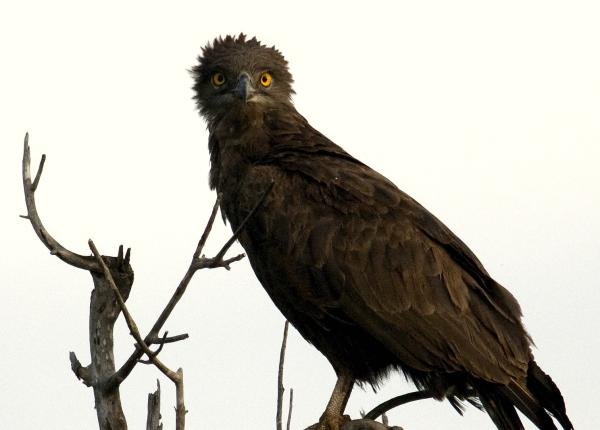Did You Know?
- This snake-eating eagle will decapitate its prey - dead snakes - before bringing them to the nest!
- The Brown Snake-eagle is the largest of all the snake-eagles.
How The Peregrine Fund is Helping
In Kenya, our scientists are working hard to learn about and protect all raptors and their habitats. Through environmental education efforts, they also are working to put a stop to the common practice of poisoning carcasses to kill large predators, which also kills a host of wildlife including vultures, eagles, and other scavenging birds. These efforts will certainly benefit all raptors of the region, including the Brown Snake-eagle.
Where They Live
The Brown Snake-eagle is found throughout much of sub-Saharan Africa. However, it is more common in some habitat types than others. If you were to search for a Brown Snake-eagle, your best bet would be to scan the skies or exposed perches in dry woodlands, and thorn and broad-leafed savannas. It tends to avoid more arid steppe and grassland habitats. It can also sometimes be seen near farmlands or at the edge of urban areas.
What They Do
True to its name, the Brown Snake-eagle is mostly a rich, dark brown all over. It has a relatively long tail that is marked with four whitish bars. Adults have yellow to orange-colored eyes. These birds also have very heavily scaled tarsi, or legs, which is certainly an adaptation to help keep them safe when hunting venomous snakes.
This eagle spends a lot of time perched in a tall or exposed tree or on an electricity pylon.
Why They Need our Help
Thankfully, the Brown Snake-eagle is categorized as a species of Least Concern by the IUCN. This means that scientists aren't too worried about the future of this species. This is probably so because the species has a large range over much of sub-Saharan Africa. Even so, it is considered uncommon in most areas.
While there is a lot for us to learn about this beautiful raptor, it is very likely that habitat destruction is having a negative effect on this species.
What They Eat
The Brown Snake-eagle eats... drum roll please... snakes! While you probably already guessed that bit of information when you first heard this bird's name, you might not know that it actually seems to specialize in preying on extremely venomous snakes. It is known to hunt cobras and Puff Adders! Though many of the snakes they feed on are venomous, they will prey on other snake species as well. While it almost always eats snakes, that doesn't mean it will turn down a good meal of lizards or other small vertebrates, such as wild and domestic birds, when the opportunity arises.
When this bird is on the hunt, it sits on an open, exposed perch, usually in a tree, waiting. When it spots its prey, it glides down and attacks it with its strong feet and toes.
Nests, Eggs, and Young
The Brown Snake-eagle, like most other eagles, builds its own nest. Using sticks and twigs it constructs a small nest high in the tops of trees. They often select trees with dense foliage, which helps keep their nest hidden. They have also been known to build their nests in a clump of epiphytes. Though not very common, scientists have even found these birds in nests they built on a power pylon.
Similar to other eagle species, the adults will line the nest with green foliage, often continuing to place fresh leaves while the eggs are being incubated. The female Brown Snake-eagle only lays one egg. She is responsible for caring for this egg until it hatches, about 50 days later! During this entire time, the male helps out by searching for and catching enough food to feed himself and the female. After the eaglet hatches, it will need to eat often. It will get busy going about the important job of growing into a powerful hunter. It will take this bird about 100 days or more of growing and gaining strength before it is ready to fly for the first time.
Brown Snake-eagle and the World Center for Birds of Prey
The World Center for Birds of Prey offers fun ways to learn about raptors of all kinds. Interactive activities, tours, interesting videos and a children's room with activities from coloring sheets and quizzes to costumes and a touch table are available for the curious mind. We also have several different birds of prey on display year-round, including several eagle species! Though we don't have any resident Brown Snake-eagles at the World Center for Birds of Prey, if you visit you will be rewarded with an opportunity to meet Fancy, our resident Ornate Hawk-eagle, and Grayson a Harpy Eagle. At the visitor center, you will see these amazing birds of prey, and others, up close in our outdoor aviary. Our knowledgeable staff is on hand to answer any questions you may have.
References:
Global Raptor Information Network. 2021. Species account: Brown Snake Eagle Circaetus cinereus. Downloaded from http://www.globalraptors.org on 16 Aug. 2021
Kemp, A. C. and J. S. Marks (2020). Brown Snake-Eagle (Circaetus cinereus), version 1.0. In Birds of the World (J. del Hoyo, A. Elliott, J. Sargatal, D. A. Christie, and E. de Juana, Editors). Cornell Lab of Ornithology, Ithaca, NY, USA. https://doi.org/10.2173/bow.brseag1.01










